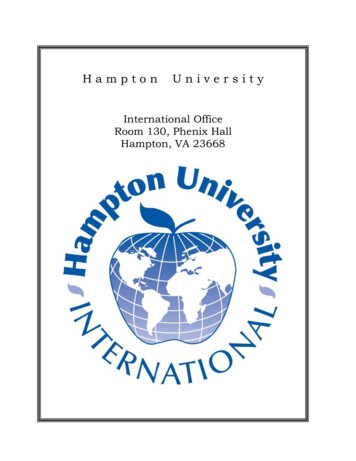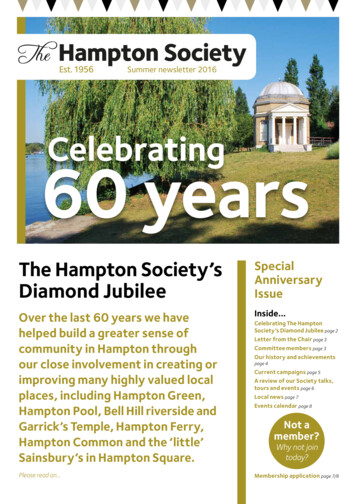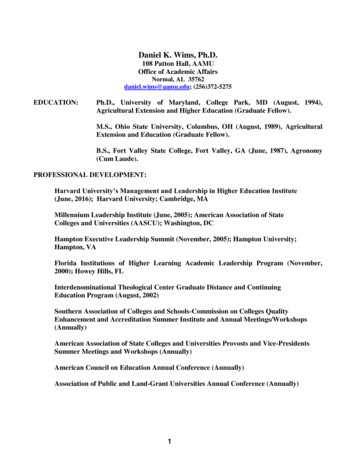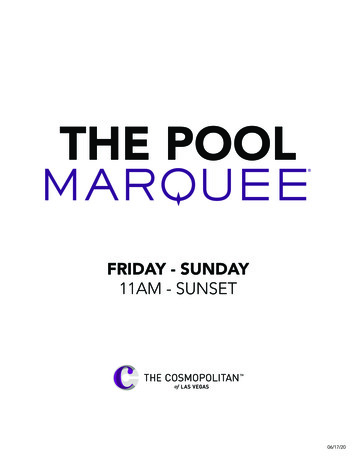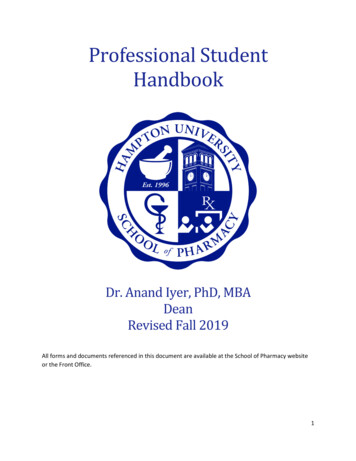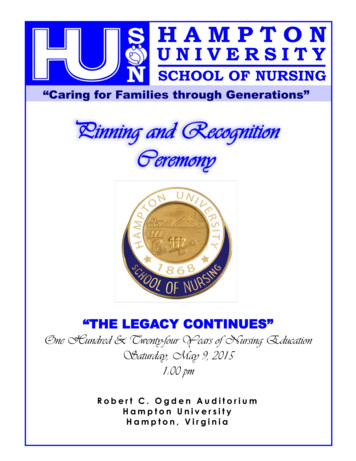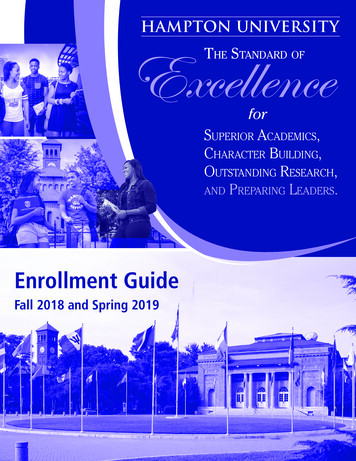
Transcription
Hampton UniversityAcademic Catalog 2016-2018
Hampton University adheres to the principle of equal education and employment opportunity without regard to race, sex, color, creed, national origin or disability.This policy extends to all programs and activities supported by the University; including the Undergraduate College, University College, College of Virginia Beach, and theGraduate College.Hampton University’s Drug-Free Work Place policy concerning the use, distribution, possession, transport or sale of illicit, over-the-counter, and prescription drugs andalcohol, incorporates regulations promulgated by the Federal Drug-Free Work Place Act of 1988, and the Department of Education’s Drug-Free Schools and Communities ActAmendments of 1989, Public Law 101-226. Both laws are inclusive for administrators, faculty, students and all other employees working on Hampton University’s properties,on or off campus. This policy has been distributed, posted and is communicated annually through educational reminders.For information regarding admission, please address correspondence to:Director of University Admissions, Dean of the University College, or Dean of the Graduate College (as appropriate)Hampton UniversityHampton, VA 23668Entered as Third Class Matter at Hampton, VA and other mailing offices.The information in this catalog is to be regarded as a binding contract between the applicant or the student and Hampton University; however, the University reservesthe unilateral right to change the requirements, regulations, rules, and fees set forth herein at any time without prior notice.2 Hampton University 2016-2018
ContentsGeneral Information. 5Degrees and Programs. 8Fees and Expenses 2016-2018. 13Student Financial Aid. 17General Academic Policies and Regulations. 22Student Affairs and Services. 30Hampton Institute . 47Undergraduate Admission. 48Academic Policies and Regulations. 51School of Business. 55School of Engineering and Technology. 64Scripps Howard School of Journalism and Communications. 75School of Liberal Arts and Education . .80School of Nursing. 121School of Pharmacy. 129School of Science. 131William R. Harvey Leadership Institute. 151Freddye T. Davy Honors College. 152University College. 153Hampton University Online. 172College of Virginia Beach. 187Graduate College. 191Main Campus Course Descriptions. 231University College Descriptions. 393Hampton University Online Course Descriptions. 415College of Virginia Beach Course Descriptions. 457The Register. 471Index. 473Hampton University 2016-2018 Contents3
Hampton University Code of ConductJoining the Hampton Family is an honor and requires each individual to uphold the policies, regulations, and guidelines established for students, faculty, administration, professional and otheremployees, and the laws of the Commonwealth of Virginia. Eachmember is required to adhere to and conform to the instructionsand guidance of the leadership of his/her respective area. Therefore, the following are expected of each member of the HamptonFamily:l. To respect himself or herself.Each member of the Hampton Family will exhibit a high degreeof maturity and self-respect and foster an appreciation for othercultures, one’s own cultural background, as well as the culturalmatrix from which Hampton University was born. It is onlythrough these appreciations that the future of our university canbe sustained indefinitely.2. To respect the dignity, feelings, worth, and values of others.Each member of the Hampton Family will respect one anotherand visitors as if they were guests in one’s home. Therefore, toaccost, cajole, or proselytize students, faculty or staff, parentsor others, to engage in gender and sexual harassment, use vile,obscene or abusive language or exhibit lewd behavior, to possess weapons such as knives or firearms, or to be involved in thepossession, use, distribution of and sale of illegal drugs is strictlyprohibited and is in direct violation of the Hampton UniversityCode, on or off campus.3. To respect the rights and property of others and to discouragevandalism and theft.Each member of the Hampton Family will refrain from illegalactivity, both on and off campus, and will be subject to all applicable provisions listed in the Faculty Handbook, Personnel Policies Manual for Administrative/Professional and Non-exemptEmployees, the Official Student Handbook, and the HamptonUniversity Code.4 4. To prohibit discrimination, while striving to learn from differences in people, ideas, and opinions.Each member of the Hampton Family will support equal rightsand opportunities for all, regardless of age, sex, race, religion,disability, ethnic heritage, socio-economic status, political,social, or other affiliation or disaffiliation, or sexual preference.5. To practice personal, professional, and academic integrity, andto discourage all forms of dishonesty, plagiarism, deceit, and disloyalty to the Code of Conduct.Personal, professional, and academic integrity is paramount tothe survival and potential of the Hampton Family. Therefore,individuals found in violation of Hampton University’s policiesagainst lying, cheating, plagiarism, or stealing are subject to disciplinary action, which could possibly include dismissal from theUniversity.6. To foster a personal professional work ethic within the HamptonUniversity Family.Each employee and student of the Hampton Family must strivefor efficiency and job perfection. Each employee must exhibita commitment to serve and job tasks must be executed in ahumane and civil manner.7. To foster an open, fair, and caring environment.Each member of the Hampton Family is assured equal and fairtreatment on the adjudication of all matters. In addition, it isunderstood that intellectual stimulation is nurtured through thesharing of ideas. Therefore, the University will maintain an openand caring environment.8. To be fully responsible for upholding the Hampton UniversityCode.Each member of the Hampton Family will embrace all tenets ofthe Code and is encouraged to report all code violators.Hampton University 2016-2018
General InformationFounded in 1868, Hampton University’s main campus is locatedon 270 acres of Virginia’s Peninsula at the mouth of the ChesapeakeBay and is the oldest private, nonsectarian, co-educational, postsecondary institution in the southeast Commonwealth of Virginia.Hampton University is an historically black, privately endowed,co-educational institution of higher education founded in 1868 forthe education of African Americans. In 1916, Hampton achievedstatus as a four-year secondary school by the Virginia Departmentof Public Instruction. The first bachelor’s degrees were offered in1922. Courses at the secondary level were dropped gradually, andall resources of the institution were applied to education at thecollege level. Accreditation as a Class “A” College was achievedduring the 1932-33 academic year. In recognition of the growthand evolution of the school, in 1984 the Board of Trustees adoptedthe name Hampton University, while continuing to use the nameHampton Institute for the undergraduate college. Hampton initiated the following doctoral degree programs: the Doctor of Philosophy in Physics and in Nursing (1992 and 1999, respectively);the Doctor of Pharmacy (1998); and the Doctor of Physical Therapy(1999). Today, there are over 5,000 undergraduate and nearly1,000 graduate and professional students. Approximately 88%of the students are African American, nearly 9% are Caucasianand the remaining 3% are from other ethnic groups, includingNative American, Asian, and Hispanic students. Hampton University ranks high in the South and Southeast due to its selectivity inadmission, high standards of teaching, rigorous curricula and theprofessional activities of the faculty.The Mission StatementHampton University is a comprehensive institution of highereducation, dedicated to the promotion of learning, building ofcharacter, and preparation of promising students for positions ofleadership and service. Its curricular emphasis is scientific andprofessional with a strong liberal arts undergirding. In carryingout its mission, the University requires that everything that it doesbe of the highest quality.An historically black institution, Hampton University is committed to multiculturalism. The University serves students fromdiverse national, cultural, and economic backgrounds. From itsbeginning to the present, the institution has enrolled studentsfrom five continents — North America, South America, Africa,Asia and Europe — and many countries including Gabon, Kenya,Ghana, Japan, China, Armenia, Great Britain and Russia, as wellas the Hawaiian and Caribbean Islands and numerous AmericanIndian nations. Placing its students at the center of its planning,the University provides a holistic educational environment. Learning is facilitated by a range of educational offerings, a rigorouscurriculum, excellent teaching, professional experiences, multipleleadership opportunities, and an emphasis on the developmentof character which values integrity, respect, decency, dignity, andresponsibility.Hampton University 2016-2018 Research and public service are integral parts of Hampton’smission. In order to enhance scholarship and discovery, facultyare engaged in writing, research and grantsmanship. Faculty, staffand students provide leadership and service to the University aswell as the global community.In achieving its mission, Hampton University offers exemplaryprograms and opportunities, which enable students, faculty andstaff to grow, develop and contribute to society in a productive,useful manner.HistoryWhen the Hampton Normal and Agricultural Institute openedits doors in April 1868, in the days of Reconstruction, listed asassets were two teachers, fifteen students, little money or equipment, and the faith in its principle of “learning by doing” and “education for life.”The principal was Samuel Chapman Armstrong, a 29-yearold Brigadier General, son of missionary parents. He had beenassigned by the Freedmen’s Bureau to help solve the problems ofthe thousands of former slaves who had gathered behind Unionlines on the Virginia Peninsula. He founded, with the aid of theAmerican Missionary Association, a school at Hampton to trainselected young men and women “who should go out and teachand lead their people, first by example, and in this way to build upan industrial system for the sake not only of self-support and intelligent labor, but also for the sake of character.” His goal was totrain “the head, the hand, and the heart” of Hampton’s students.Hampton may well be thankful that in the concept of “Education for Life”—including efficiency, character, and usefulnessto society—General Armstrong established a standard timelessin its appeal and application. Hampton today finds this concepthighly adaptable to the changing conditions of life in this century and the likely challenges of the future. The first conditions foradmission were simple: “Sound health, good character, age notless than fourteen years and not more than twenty-five, ability toread and write intelligibly, knowledge of arithmetic through longdivision, intention to remain throughout the whole course of threeyears and to become a teacher.”Support in the early days came from philanthropic and religiousgroups and individuals, from Federal Land Grant Funds (18721920), and numerous other sources. With the help of the Freedmen’s Bureau and northern philanthropists, the school was ableto erect a classroom building—Academic Hall, since rebuilt—in1869. Residence quarters, however, continued to be a problem,with the men living in army tents for three years and the womenliving in barracks until the completion of Virginia Hall in 1874.Some of the money for this building was raised by the HamptonSingers, who toured northern communities.General Information5
In 1878, a group of American Indian men arrived at Hampton,their studies here supported in part by federal funds. These appropriations were continued until 1912. American Indian studentscontinued to attend Hampton in this historic program until 1923.After his death in 1893, General Armstrong’s work was continued and expanded for nearly a quarter-century under the leadership of Reverend Hollis B. Frissell. In 1916, Hampton achievedstatus as a four-year secondary school by the Virginia Departmentof Public Instruction. The first bachelor’s degrees were offered in1922. Courses at the secondary level were dropped gradually, andall resources of the institution were applied to education at thecollege level. In 1930, the school’s name was changed to HamptonInstitute, and the title of its chief officer from principal to president. Accreditation as a Class “A” College was achieved duringthe 1932-33 academic year.In line with its broadening educational program, the collegeinaugurated graduate courses in 1928. Course work leading to theMaster of Arts degree in education was offered during summerschool sessions only. Although discontinued in 1949, graduatestudy was reactivated in 1956, and for the first time was offeredduring the regular year as well as during summer school. A Division of Graduate Studies was organized in 1956 as the administrative unit to replace the former Division of Summer ExtensionStudy. Then, in October 1967, following a visitation by representatives of the Southern Association of Colleges and Schools, a newall-institution faculty committee, the Graduate Council, was organized. A Master of Arts in Nursing was added in 1976 and Communication Disorders in 1977. The degree of Master of Science inBiology, Communication Disorders and Nursing was approved forthe 1978-79 academic year. The Master of Science in Management and the Master of Business Administration were approvedfor the 1982-83 academic year.LocationHampton University’s beautiful campus is located along thebanks of the Hampton River on Virginia’s Peninsula, where theJames and York rivers join. The region is closely associated withearly American history. A large Kecoughtan community was oncelocated in the vicinity of the campus and Jamestown, where thefirst group of captive Africans arrived in the New World, is onlya few miles up the James River. The area is presently the hubof Norfolk - Newport News - Portsmouth military defense activity, provided by United States Navy, Air Force, and Army installations. Within a radius of 40 miles from the campus are the historic localities of Jamestown, Yorktown, and Williamsburg. TheCity of Hampton is America’s oldest continuous English-speakingsettlement. A center for East Coast conventions, tourism, and theHampton Jazz Festival, the city supports public beaches, campgrounds, tennis courts, and golf courses in addition to its historicattractions. Hampton Roads, one of the world’s largest naturalharbors, offers the total spectrum of water sports to area residents, students, and visitors.6 General Information Buildings and GroundsThe Emancipation Oak, more than ninety-eight feet in diameter,is designated as one of the ten great trees in the world by theNational Geographic Society. The live oak got its name becausethe Emancipation Proclamation was read to Hampton area residents there in 1863. Legend has it that the shade of the Oakserved as the first classroom for a newly freed people seeking theblessings of education.Five buildings on campus are registered as National HistoricLandmarks. The Mansion House, built in 1828, is the only buildingon campus that predates the founding of the University. It servesas the official residence for the University president and his family. The Memorial Church, erected in 1886, features a 150-foottower and an illuminated clock with chimes. Wigwam Buildingwas originally built in 1878 to house American Indian male students, the first of whom were admitted in that same year. Today,the building is used as an educational resource center. VirginiaCleveland Hall was erected in 1874 and is used as a women’sdormitory. The student cafeteria is located on the first floor.Academic Hall was erected in 1869 and was used for classrooms, the library, museum, and a male dormitory. Destroyed byfire in 1879, Academy Building was rebuilt and dedicated in 1881.Huntington Building (1903) is the home of the University Museumand Archives. Today, outstanding works of art and cultural objectsare displayed to students and visitors in well-designed exhibitsand other educational programs. Exceptionally strong in the areasof African, American Indian, and African-American art, Hampton’scollection is known to be the largest and most important of itskind in the Southeast and one of America’s unique and significantmuseum resources. Containing over 8 million manuscript materials and 50,000 photographs, the Archives is among the nation’smost important resources for research on the history of AfricanAmerican and American Indian education.Long recognized as an important cultural center in HamptonRoads, Ogden Hall (1918) has the reputation for having the bestacoustics in the State of Virginia. It is used by the University forceremonial occasions and cultural performances, as well as bymany professional companies.This picturesque campus, surrounded on three sides by water,comprises some 50 main buildings and 75 auxiliary structuresspread out over 270 acres for easy access. The academic buildingscontain state-of-the-art equipment accessible to students andfaculty. Some of the recent additions to the physical plant includea new Research Center, a Multi-Use Facility, and a new softballfield. The Research Center is an 18,000 square foot two-storybuilding dedicated to scientific research. This building will serveas an interdisciplinary facility that will attract scientists from allover the world. The building houses office space for programs inphysics, pharmacy, and a robotics laboratory as well as the Skin ofColor Research Institute. The Multi-Use Facility, a 35,798 squarefoot building, houses offices and a women’s residence hall. Thefirst floor accommodates the Career Center, University Relations,Alumni Affairs, and the lobby of the women’s residence hall. Thesecond and third floors house residence hall spaces that accom-Hampton University 2016-2018
modate approximately 75 female students. This is a non-smokingfacility with geothermal energy efficient heating, ventilation andair conditioning systems. In keeping with Hampton University’s“Going Green” initiative, LEED Strategies were used in the construction of this facility. The new softball field, located on Emancipation Drive, meets all of the National Collegiate Athletic Association (NCAA) guidelines and regulations.The Hampton University Proton Therapy Institute (HUPTI)located in Hampton, Virginia, and an integral part of Hampton University, is a 98,000 square foot cancer treatment facility specializing in proton therapy treatment delivery. HUPTI is the eighth proton facility in operation in the United States, and the first protonfacility owned by an historically Black college or university. TheCenter has five treatment rooms and the first patient was seen inAugust 2010. HUPTI will be a catalyst for new scientific discoveries and increasingly accurate, advanced care for cancer patients.Currently, Hampton University is in the process of building aMultidisciplinary Biomedical Research Center and a new state-ofthe-art Dining Facility. The Multidisciplinary Biomedical ResearchCenter will be a two-story 25,000 square foot building dedicatedto biomedical research. The University’s goal is to create a unique,interdisciplinary scientific environment. The new Dining Facilitywill service approximately 3,400 on-campus students and willconsist of a main kitchen plus out-front cooking stations that willinclude stir-fry, grilled items, deli and pasta areas along with acentral beverage and dessert station.The Hampton University College of Virginia Beach opened inAugust, 2003 in Hampton Roads’ newest and tallest business andcommercial hub, the Town Center building. This modern facilityprovides its students, faculty and business/government clientswith a state-of-the-art educational and instructional environment.By incorporating the latest in learning technologies, the Collegeof Virginia Beach is ideally equipped to advance the academic andeconomic development of the state’s most populous city and thesurrounding region.University LibrariesThe Libraries support the University’s mission to promote learning and excellence in teaching by providing access to a wide arrayof information resources, services and facilities. Hampton University students, faculty, staff, researchers and scholars constitutethe primary users of the University Libraries. The resources ofthe campus libraries are enhanced as a result of membership inseveral networks and consortia serving academic libraries. TheHampton University Library is a member of the Virginia TidewaterConsortium (VTC), the Virginia Independent College and University Library Association (VICULA), The Virginia Peninsula LiteraryConsortium (VPLC), the Historically Black Colleges and Universities (HBCU) Library Alliance and the the Virtual Library of Virginia(VIVA). The sharing of resources by the network of academic libraries is accomplished through the use of interlibrary loan, reciprocal borrowing, the shared cataloging of materials, online accessto holdings, bibliographic databases and cooperative purchasing.Hampton University’s libraries include the William R. and NormaB. Harvey Library (main) and satellite units in the Department ofHampton University 2016-2018 Architecture, the Department of Music and The Hampton University College of Virginia Beach.The William R. and Norma B. Harvey Library was dedicatedand opened officially on January 26, 1992. This five-story facility houses the main library collection, including over 400,000volumes; over 62,000 bound periodicals and more than 640,000microforms. The library regularly receives print periodicals including journals, proceedings, magazines and newspapers.Two special collections add depth to the general holdings: (1)the selective U. S. Government documents depository, and (2) theGeorge Foster Peabody Collection of more than 33,000 catalogeditems by and about African Americans.Users gain access to the library’s holdings through the HamptonUniversity Online Web-based Catalog (HUWebCat). Bibliographicrecords are available for adaptive cataloging through the OnlineComputer Library Center (OCLC) subscription service which provides cataloging services and products in support of informationmanagement and access. The library management system is themost recent version of the SIRSI SYMPHONY client based systemof software and equipment.Online access to citations, abstracts, full-text articles, electronic journals, e-books, government documents, dissertations,and other reference sources is provided by accessing the library’swebsite. Students and faculty are able to access electronicresources from the website both on and off campus. The librarymaintains licensed agreements to databases, electronic journalsand e-books. Library instruction and web tutorials are provided tohelp students and faculty use resources effectively.In addition to the above, open shelves afford users the privilege of direct access to books, bound periodicals and audio-visualmaterials. The library has individual study areas on each floor andprovides areas for group study and collaboration. Additionally, thelibrary provides faculty carrels for university faculty and staff toutilize for research. Other areas of usage in the library include a24-hour study area, a vending area, a multi-purpose meeting roomseating 100, an electronic classroom, and a conference room.Wi-fi is available throughout the Harvey Library building for connectivity of electronic devices.Regional AccreditationHampton University is accredited by the Commission on Colleges of the Southern Association of Colleges and Schools toaward degrees at the associate, baccalaureate, master’s, education specialist and doctorate levels. Contact the Commission onColleges at 1866 Southern Lane, Decatur, Georgia 30033-4097 orcall 404-679-4500 for questions about the accreditation of Hampton University. The Commission requests that it be contacted onlyif there is evidence that appears to support an institution’s significant non-compliance with a requirement or standard.General Information 7
Academic Rating and MembershipFrom humble origins, Hampton University has evolved into aprestigious, nationally acclaimed university that sets The Standardof Excellence in education. The University is a privately endowed,co-educational, nonsectarian institution of higher education withaccreditation by the Department of Education of the Commonwealth of Virginia and holds membership in the Council of Graduate Schools, the Council of Independent Colleges in Virginia, andthe American Council on Education. Its programs in architecture,business, chemistry, communicative sciences and disorders, computer science, chemical and electrical engineering, journalism,music, nursing, pharmacy, physical therapy and teacher education are accredited by their respective accrediting agencies. Thearchitecture program is accredited by the National ArchitecturalAccrediting Board. The business programs are accredited by theInternational Assembly for Collegiate Business Education. Thechemistry program is approved by the Committee on ProfessionalTraining of the American Chemical Society. The program in communicative sciences and disorders is accredited at the graduatelevel by the American Speech - Language - Hearing Association.The undergraduate computer science program is accredited bythe Computing Accreditation Commission of ABET, 111 MarketPlace, Suite 1050, Baltimore, MD 21202-4012 – telephone: (410)347-7700. The chemical and electrical engineering programsare accredited by the Engineering Accreditation Commission ofABET, 111 Market Place, Suite 1050, Baltimore, MD 21202-4012 –telephone: (410) 347-7700. The Scripps Howard School of Journalism and Communications maintains accreditation for the undergraduate programs in Broadcast Journalism, Print Journalism andPublic Relations from the Accrediting Council on Education in Journalism and Mass Communications (ACEJMC), Stauffer-Flint Hall,1435 Jayhawk Blvd, Lawrence, KS 66045-7575 – telephone (785)864-3973. The music programs are accredited by the NationalAssociation of Schools of Music. The undergraduate and graduate nursing programs are fully accredited by the National Leaguefor Nursing Accrediting Commission, Inc. and by the Commissionon Collegiate Nursing Education; the undergraduate program isapproved by the Virginia State Board of Nursing. The School ofNursing is also an agency member of the Department of Baccalaureate and Higher Degree Programs of the National League forNursing, the Nursing Council o
4 Hampton University 2016-2018 Hampton University Code of Conduct Joining the Hampton Family is an honor and requires each indi-vidual to uphold the policies, regulations, and guidelines estab-lished for students, faculty, administration, professional and other employees, and the laws of the Commonwealth of Virginia. Each
